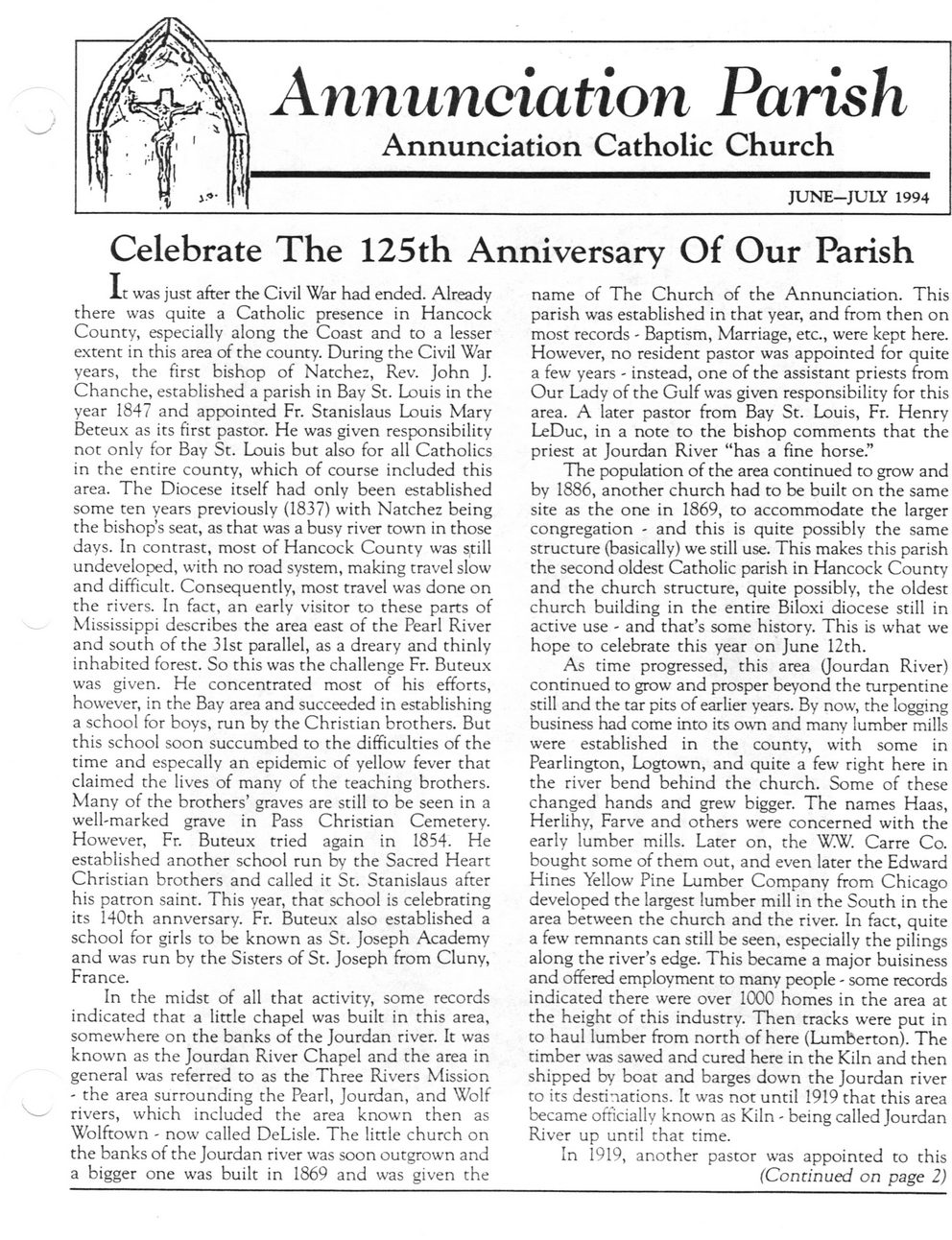This text was obtained via automated optical character recognition.
It has not been edited and may therefore contain several errors.
Annunciation Parish Annunciation Catholic Church JUNE-JULY 1994 Celebrate The 125th Anniversary Of Our Parish It was just after the Civil War had ended. Already there was quite a Catholic presence in Hancock County, especially along the Coast and to a lesser extent in this area of the county. During the Civil War years, the first bishop of Natchez, Rev. John J. Chanche, established a parish in Bay St. Louis in the year 1847 and appointed Fr. Stanislaus Louis Mary Beteux as its first pastor. He was given responsibility not only for Bay St. Louis but also for all Catholics in the entire county, which of course included this area. The Diocese itself had only been established some ten years previously (1837) with Natchez being the bishop’s seat, as that was a busy river town in those days. In contrast, most of Hancock County was still undeveloped, with no road system, making travel slow and difficult. Consequently, most travel was done on the rivers. In fact, an early visitor to these parts of Mississippi describes the area east of the Pearl River and south of the 31st parallel, as a dreary and thinly inhabited forest. So this was the challenge Fr. Buteux was given. He concentrated most of his efforts, however, in the Bay area and succeeded in establishing a school for boys, run by the Christian brothers. But this school soon succumbed to the difficulties of the time and especally an epidemic of yellow fever that claimed the lives of many of the teaching brothers. Many of the brothers’ graves are still to be seen in a well-marked grave in Pass Christian Cemetery. However, Fr. Buteux tried again in 1854. He established another school run by the Sacred Heart Christian brothers and called it St. Stanislaus after his patron saint. This year, that school is celebrating its 140th annversary. Fr. Buteux also established a school for girls to be known as St. Joseph Academy and was run by the Sisters of St. Joseph from Cluny, France. In the midst of all that activity, some records indicated that a little chapel was built in this area, somewhere on the banks of the Jourdan river. It was known as the Jourdan River Chapel and the area in general was referred to as the Three Rivers Mission - the area surrounding the Pearl, Jourdan, and Wolf rivers, which included the area known then as Wolftown - now called DeLisle. The little church on the banks of the Jourdan river was soon outgrown and a bigger one was built in 1869 and was given the name of The Church of the Annunciation. This parish was established in that year, and from then on most records - Baptism, Marriage, etc., were kept here. However, no resident pastor was appointed for quite a few years - instead, one of the assistant priests from Our Lady of the Gulf was given responsibility for this area. A later pastor from Bay St. Louis, Fr. Henry LeDuc, in a note to the bishop comments that the priest at Jourdan River “has a fine horse.” The population of the area continued to grow and by 1886, another church had to be built on the same site as the one in 1869, to accommodate the larger congregation - and this is quite possibly the same structure (basically) we still use. This makes this parish the second oldest Catholic parish in Hancock County and the church structure, quite possibly, the oldest church building in the entire Biloxi diocese still in active use - and that’s some history. This is what we hope to celebrate this year on June 12th. As time progressed, this area (Jourdan River) continued to grow and prosper beyond the turpentine still and the tar pits of earlier years. By now, the logging business had come into its own and many lumber mills were established in the county, with some in Pearlington, Logtown, and quite a few right here in the river bend behind the church. Some of these changed hands and grew bigger. The names Haas, Herlihy, Farve and others were concerned with the early lumber mills. Later on, the WW. Carre Co. bought some of them out, and even later the Edward Hines Yellow Pine Lumber Company from Chicago developed the largest lumber mill in the South in the area between the church and the river. In fact, quite a few remnants can still be seen, especially the pilings along the river’s edge. This became a major buisiness and offered employment to many people - some records indicated there were over 1000 homes in the area at the height of this industry. Then tracks were put in to haul lumber from north of here (Lumberton). The timber was sawed and cured here in the Kiln and then shipped by boat and barges down the Jourdan river to its destinations. It was not until 1919 that this area became officially known as Kiln - being called Jourdan River up until that time. In 1919, another pastor was appointed to this (Continued on page 2)

Kiln History Document (169)